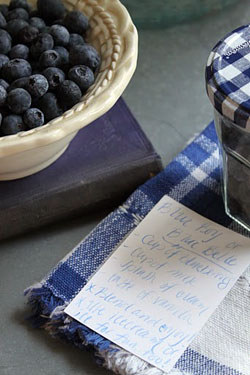 Summer is bright red, hot, juicy and sweet. So it's ironic that tomatoes don't really become ripe until the last gasp of Summer and into early Fall. To savor a bit more of the flavor of Summer, I recently made a delicious variation on the Genovese pesto recipe, a Sicilian recipe from Trapani with chunks of ripe tomato.
Summer is bright red, hot, juicy and sweet. So it's ironic that tomatoes don't really become ripe until the last gasp of Summer and into early Fall. To savor a bit more of the flavor of Summer, I recently made a delicious variation on the Genovese pesto recipe, a Sicilian recipe from Trapani with chunks of ripe tomato.
Trapanese Pesto is a twist on the classic and in addition to tomatoes, it includes some mint, almonds, a dash of chili and pecorino instead of parmesan cheese. While I'm sorry I didn't try get to try this pesto when I was in Trapani, I am very glad I discovered it. Trapenese Pesto is spicier and more full-bodied than the Genoa version with cool and hot tones all at once. The almonds give it a distinctive creaminess.
I reviewed quite a few recipes before coming up with my own recipe. Like the more famous pesto there is no definitive version so if you feel like adding more oil or a handful of pine nuts, go right ahead. While sundried tomatoes are available all year round and make a lovely pesto, try this version now while fresh tomatoes are still sweet and juicy.
Summer
Summer
Strawberry Fields Forever
 As far back as I can remember, every June my family would make our
annual pilgrimage to Jones' Farm to pick bright red juicy strawberries.
If we didn't leave with a heaping boxful then we didn't do our jobs.
But as a kid I would always end up picking more for myself than for the
box, eating every other berry and leaving with the tell-tale signs on
my hands and face. I was just as guilty as the next kid, so actually I
didn't feel that bad. Now as an adult I typically taste only one and
try to keep myself from eating any more. I'm really just saving up for
gorging on them in the privacy of my own home.
As far back as I can remember, every June my family would make our
annual pilgrimage to Jones' Farm to pick bright red juicy strawberries.
If we didn't leave with a heaping boxful then we didn't do our jobs.
But as a kid I would always end up picking more for myself than for the
box, eating every other berry and leaving with the tell-tale signs on
my hands and face. I was just as guilty as the next kid, so actually I
didn't feel that bad. Now as an adult I typically taste only one and
try to keep myself from eating any more. I'm really just saving up for
gorging on them in the privacy of my own home.
You
really have to love strawberries to pick them yourself. After all that
bending and picking, it's easy for a person to get tired. I must love
them so much, because last week on a sunny yet breezy Monday morning,
with the help of my mom, I picked 13 pounds of strawberries. But aren't
strawberries easy to love? I don't think I know anyone who doesn't
adore them. They're so sweet and mushy once you eat them. It's one of
the most favorite flavors in ice cream and candy. Even lotions and some
cosmetics are flavored with strawberries. That just shows you how
extremely popular the flavor actually is.
A Boston Harbor Picnic
 Mountain tops, leafy glades, pastures? Not for us. We're having our picnic in Columbus Park overlooking Boston harbor. Leave your meat and fancy picnic set-ups at home; there are no grills or tables, just trees, grass and benches and other people's yachts, of course.
Mountain tops, leafy glades, pastures? Not for us. We're having our picnic in Columbus Park overlooking Boston harbor. Leave your meat and fancy picnic set-ups at home; there are no grills or tables, just trees, grass and benches and other people's yachts, of course.
We like simple egg salad and tuna salad. Hard boil four eggs and refrigerate. Cut two stalks of celery into tiny pieces. Combine eggs with Hellman's mayo. Season with salt and pepper; add dry mustard if you must. Transfer to a disposable plastic container. Next, drain a can of cold tuna. Dice celery and add Hellman's, not too much. Add a dash of pepper, onions if you must. Garnish with parsley if you're a food writer.
Transfer to a separate container with a tight cover. Finally, cut grape tomatoes in thirds, then peel one cold and dry cucumber. Pack together in a third small container. If you freeze a couple of bottled waters, they'll keep everything cold.
Watermelon-Coconut-Lime Popsicles
 My kids looovvveee popsicles and at some point during the day someone always has a Big Stick or a red-white-and-blue Rocket Pop in hand. While I can be happy with a cherry-pineapple flavored Big Stick, I prefer more of a tropical taste when it comes to popsicles.
My kids looovvveee popsicles and at some point during the day someone always has a Big Stick or a red-white-and-blue Rocket Pop in hand. While I can be happy with a cherry-pineapple flavored Big Stick, I prefer more of a tropical taste when it comes to popsicles.
Last week I was working away at my desk and I literally jumped up to make these. The idea of watermelon, coconut and lime came over me like a wave. Before I knew it these were headed to the freezer.
Have you made popsicles at home? It’s so easy, especially with the right mold. It takes nothing to whir some flavors up in a blender, the possibilities are endless.
I think the coconut cream I use in this recipe gives this a more “adult” taste. Coconut cream can usually be found in the Hispanic section of your grocery store or as a drink mixer in the liquor aisle. I also use it to make coconut ice cream.
Brown Sugar and Buttermilk Blueberry Poundcake
 Some things are just too good to pass up, such as the combo of blueberries and brown sugar.
Some things are just too good to pass up, such as the combo of blueberries and brown sugar.
And what else would be better than to combine them into a poundcake?
I adore poundcake. Love it more so. I’ve been kicking it up a notch lately with buttermilk, which I pretty much substitute for milk in most of my baking now. It gives a lift and kick and a richness to cakes especially. Honestly, because cakes NEED a bit more richness… enter gilding the lily terminology here.
Add in blueberries and your summer has just been captured in this dessert. Garnish with whipped cream, serve warm with ice cream and of course a few fresh blueberries, or toasted the next morning as the breakfast of champions!
From the blueberry fields flooding into to Middle Georgia into this Farmer’s kitchen and now on to yours, enjoy this delightful dessert!
More Articles ...
Welcome to the new One for the Table ...
Our Home Page will be different each time you arrive.
We're sure you'll find something to pique your interest...

